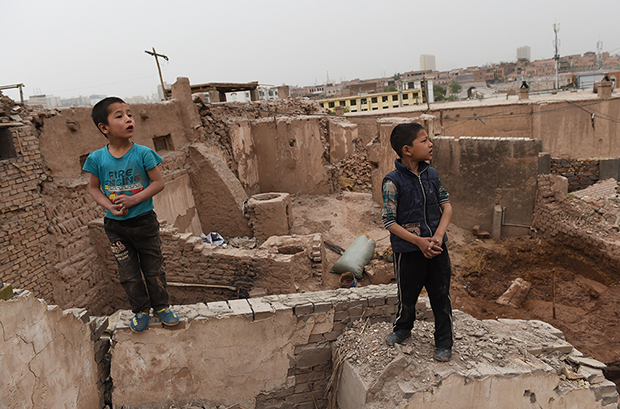It has been almost one year since a terrorist bombing in Urumqi, the capital of the Xinjiang region, shocked the nation and brought economic woes and social conflicts in the largely Uighur-populated area into the spotlight again.
I arrived by train with my colleagues in the city several hours after the tragedy, which killed 39 people and wounded more than 90 others. Armed policemen lined the streets. I was waiting for a taxi while I saw an old man in Uighur clothing, with perhaps his granddaughter, running back and forth in the streets trying to get a taxi as well, but none stopped for them.
We spent a few days in Xinjiang for work. On the day we left, we asked a taxi driver who was taking us to the airport if he could make a stop at a Uighur restaurant so we could buy some local food. He refused with some emotion, saying “I’m not taking you to buy any Uighur food!”
“Why?” I asked.
“Because they make trouble and give us a hard time with business,” he said. “Nobody wants to come to Xinjiang now.”
“But we came,” I said.
“Then why are you leaving?” he almost cried.
I froze at his anger. I had not realized the rift between Han and Uighur ethnic communities was so broad.
Media
05.23.14
“What’s Been Done to My Beautiful Homeland?”
The days I spent in Xinjiang surveying the economy and local business conditions taught me a few things. Whatever the problem is with the autonomous region, a stagnant economy is not the only factor. It is the combined result of factors in the economy, culture, and society. Government responses to the problem must take the whole picture into account because overlooking any aspect will only make the problem worse.
Take the strategy of enterprise-based industrial support of the Xinjiang economy, for example.
The idea that local governments in other parts of China could be paired up with areas inside Xinjiang to aid their development was inspired by the disaster relief work after an earthquake killed about 70,000 people in China in 2008.
In 2010, the central government required the regulators of state-owned enterprises in 19 provinces and municipalities to put the idea into action in Xinjiang. They were to encourage companies they supervised to invest in the region and share technologies and expertise with local businesses.
Over the past few years, huge amounts of capital have flown to Xinjiang through the arrangement, but the results have fallen short of many people’s expectations.
There are many reasons for this.
The NYRB China Archive
04.13.15
China: What the Uighurs See
from New York Review of BooksFirst, too many resources have been wasted building industrial parks that cannot attract occupants. Industries in Xinjiang have remained largely underdeveloped and make limited contributions to government coffers. Building industrial parks was viewed as a short-cut to boosting tax revenue, and local governments in the region bought into this idea so much that almost every county made plans to build one.
This ignored the reality that in most parts of Xinjiang, especially the southern area, there was neither proper infrastructure nor sufficient demand for manufactured goods. That means that even if an industrial park could be completed, there would probably not be enough occupants. In fact, during my trips to northern and eastern areas of Xinjiang, I found many brand new industrial parks sitting empty.
Also, the strategy put too much emphasis on resource exploration. Xinjiang has rich natural resources, and a major component of the government’s strategy is to turn them into economic benefits. This has created an incentive for all local governments to treat mining and oil and gas processing as pillar industries, regardless of their conditions. This means Xinjiang’s industrial structure lacks diversification. Also, because heavy industries are not labor-intensive, they do not need many workers. Blind pursuit of resource exploration also risks jeopardizing Xinjiang’s already fragile environment.
The third problem with the strategy is that it relies too heavily on big state-owned enterprises to make investment. Big firms and big projects can indeed drive economic growth fast, and that’s why many Xinjiang local governments favor them. From land sales to financing channels, Xinjiang’s industrial policies revolve around big SOEs, without enough attention given to the private sector.
But there is a trap. An official supervising business development in a city I visited said: “Everyone was thrilled and excited about the arrival of big centrally administered SOEs when the supporting Xinjiang policy was implemented.”
“Now four or five years have passed, and people realized these companies favor energy and mineral resources. They came and suck local wealth dry and most of their taxes go to higher-level governments. They made such a small contribution to the local government’s tax income and job market.”
Another problem with the strategy is the way it is implemented. Pairing up local governments within and without Xinjiang appears to be targeted and allows for easier assessment of results, but it also means there will be unnecessary competition among the governments, and their resource usage cannot be coordinated.
In light of these problems, I suggest the government change its policy regarding Xinjiang’s industries.
A region-wide plan for the development of industrial parks should be formed to reduce redundancy and prevent vicious competition. The choosing of sites should be based on conditions such as natural resources and infrastructure and be able to cross administrative borders. Several county or city governments should cooperate on building one industrial park, then share the risk and benefits together.
Also, the policy should encourage the development of local businesses, most of them small and medium-sized enterprises. They may not be able to contribute as much to the local GDP as big SOEs, but they hire and sell locally, and the entrepreneurship they represent will play a key role in stimulating the economy. When investors and workers pull out of Xinjiang due to safety worries, these are the companies that are more likely to stay and continue to develop.
In addition, industrial development must respect the limits of Xinjiang’s environment. It has a fragile environment and lacks water, and yet most of the oil and gas companies’ factories in the region need a lot of water. In the future, industrial policies and development should treat the capacity of the environment and especially water supply as a bottom line.




